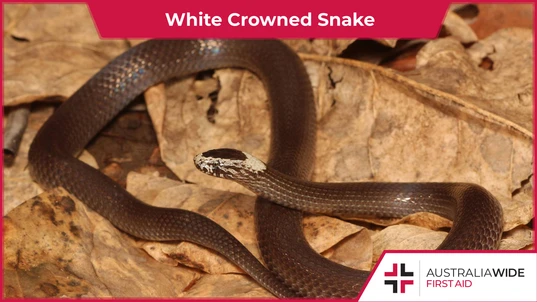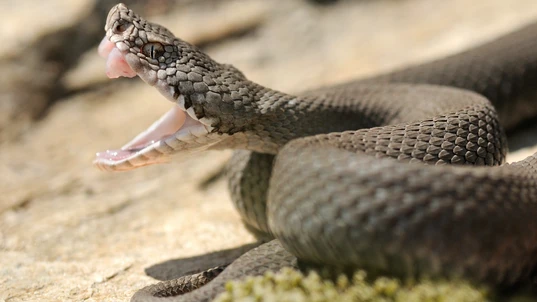All About the White Crowned Snake

Bites and Stings

The White crowned snake is abundant throughout parts of Australia's eastern coast. Continue reading for more information about their identifying characteristics, preferred habitat, and level of toxicity.
The White crowned snake is one of Brisbane's most abundant smaller snake species. As their name alludes to, these snakes have a cream coloured stripe circling their snout and neck, which gives the illusion of a crown. It is important to be wary of White crowned snakes, as they are known to thrash about wildly when threatened. Continue reading for more information about the White crowned snake, including their identifying characteristics, preferred habitat, and level of toxicity.Appearance
The White crowned snake(Cacophis harriettae) typically grows to 50 centimetres long. Apart from the cream coloured stripe on their head and neck, these snakes are dark brown to steely grey above and below. Likewise, they have a tiny mouth and short fangs.Habitat
The White crowned snake can be encountered along the east coast of Australia, from Proserpine in Queensland to northern New South Wales. They are generally concentrated in forests, woodlands, and heathland, where they generally shelter in moist areas beneath logs, rocks, and leaf litter. They have also been known to shelter in suburban gardens beneath compost heaps and around rockeries.Habits
The White crowned snake is a secretive and nocturnal species. They generally spend their nights hunting diurnal skinks and other small lizards in leaf litter. Females give birth to eggs in clutch sizes ranging from 2 to 10.Danger
When threatened, White crowned snakes are prone to adopting an impressive threat display, wherein they raise their body vertically and make jerky, striking motions. However, this is mostly for show, as they are reluctant to bite and will often keep their mouths closed when striking, thereby head-butting the victim rather than biting them. Due to the weakness of their venom, they are not considered a danger to humans. However, it is important to remember that many snake species can vary in colour, pattern, and size, and so all snake bites should be considered a medical emergency.
When you are bitten by a snake, it can be difficult to positively identify what species of snake has bitten you. As such, all snake bites should be regarded as a medical emergency and treated using the Pressure Immobilisation Technique.
Snake Bite First Aid
- Keep the casualty at rest and as still as possible to stop the venom from travelling through the body
- Constantly observe and reassure the casualty
- Follow DRSABCD and be prepared to perform CPR
- Apply the ‘pressure immobilisation technique’ (PIT):
If the bite site is on a limb, cover it with a wide heavy elastic bandage (10 - 15 cm wide)
Ensure the bandage is firm and tight, so tight you cannot easily slide a finger between the bandage and the skin
Apply a second heavy elastic bandage. Start from the fingers or toes and wind up the limb as far as possible. Consistent coverage (overlapping half over half) and consistent pressure (firm but not cutting off circulation) are key to an effective PIT - On the bandage, mark the spot where the bite occurred with a pen or felt-tip marker
- Immobilise the limb and joints with a splint, or use a sling if the bite site is on an arm. Keep the limb immobilised until the ambulance arrives
Final thoughts
The White crowned snake is a small snake species distributed across part of Australia's eastern coast. These snakes, like their closest kin (the Dwarfed crown snake and the Golden crowned snake), are largely inoffensive and spend their days sheltering beneath rocks, logs, and leaf litter. In saying that, it can be difficult to positively identify snakes, and so all snake bites should be regarded as a medical emergency. If you do encounter a snake at home or in the wild, you should never attempt to approach, capture, or kill it. You should contact a professional snake catcher if you need a snake relocated from your home. For more information on treating bites from White crowns and other snake species, book a first aid course with Australia Wide First Aid today.
Originally published at
https://www.australiawidefirstaid.com.au/resources/white-crowned-snake
as part of the Australia Wide First Aid Articles Library









